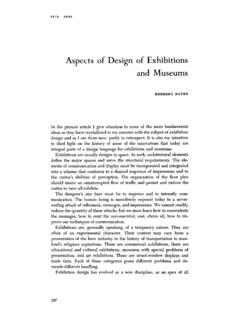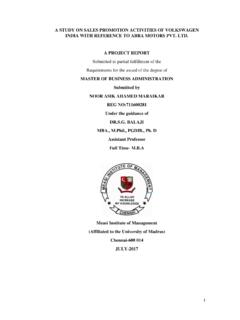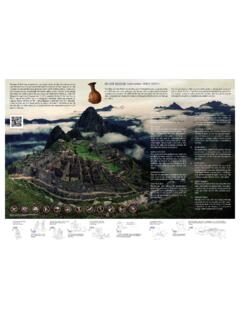Transcription of The Architecture of the Solomon R. Guggenheim Museum
1 The Architecture of the Solomon R. Guggenheim MuseumA Guide for Teachers and StudentsUSING THIS GUIDEFrom its very beginnings the Solomon R. GuggenheimMuseum has been a hub for new art and new ideas. Themuseum was designed by renowned architect Frank LloydWright to house an innovative collection of works in a uniqueenvironment. Today, the Museum continues to be a landmarkdestination that attracts visitors from around the curriculum module is designed as a resource foreducators to help introduce the unique Architecture andhistory of the Solomon R. Guggenheim Museum to can be used on its own in the classroom, as preparation fora visit to the Museum , or afterward as a post-visit the primary goal of this guide is to introduce themuseum s unique Architecture , many of the suggesteddiscussions and activities can be used to explore the history,design, and use of any chosen building. The guide is arranged according to the following sequence:TEACHER INFORMATION includes a history of theSolomon R.
2 Guggenheim Museum and biographies of thosefigures critical to its founding. VIEW + DISCUSS walks you through a guided tour of themuseum s Architecture with opportunities for careful lookingand for discovering unique aspects of the building. FURTHER EXPLORATIONS activities that respond to thearchitecture of the Solomon R. Guggenheim Museum andFrank Lloyd Wright s approach to architectural designthrough discussion, writing, and the visual arts. ADDITIONAL RESOURCESV ocabulary and definitionsfor words and phrases that may be new to students, or usedwithin a special context ( , avant-garde, non-objective art).A list of suggested books, videos, and Web sites that relatedirectly to this curriculum module. Selected color images forclass-wide viewing and discussion. Teachers are encouraged to adapt the lessons and activities inthis curriculum module to meet the needs of their INFORMATIONA Brief History of the Solomon MuseumIn June 1943, renowned architect Frank Lloyd Wrightreceived a letter from Hilla Rebay, the art advisor to Solomon R.
3 Guggenheim , asking him to design a newbuilding to house Guggenheim s collection of non-objectiveart, a radical new art form being developed by such artists as Vasily Kandinsky, Paul Klee, and Piet s one requirement of the architect was that thebuilding should be unlike any other Museum in the , in turn, created a design that he believed would be the best possible atmosphere in which to show fine paintingsor listen to music. Frank Lloyd Wright was already known asthe preeminent American architect of the 20th century, butthis invitation would add another major accomplishment tohis influential career. The project evolved into a complex struggle pitting thearchitect against his clients, city officials, the art world, andpublic opinion. Both Guggenheim and Wright would diebefore the building s 1959 completion, but their achievement,the Solomon R. Guggenheim Museum , remains. It testifiesnot only to Wright s architectural genius, but also to theadventurous spirit that characterized its made no secret of his disenchantment withGuggenheim s choice of New York City for his Museum : I can think of several more desirable places in the world tobuild his great Museum , Wright wrote in 1949, but we willhave to try New York.
4 To Wright, the city was overbuilt,overpopulated, and lacked architectural merit. Still, he proceeded with his client s wishes, consideringlocations on 36th Street, 54th Street, and Park Avenue (all inManhattan), as well as in the Riverdale section of the Bronx,before settling on the present site on Fifth Avenue between88th and 89th Streets. Its proximity to Central Park was key;as close to nature as one gets in New York, the park affordedrelief from the noise and congestion of the city. Nature not only provided the Museum with a respite fromNew York s distractions but also lent it inspiration. TheGuggenheim Museum is an embodiment of Wright sattempts to incorporate organic form into Architecture . Onone of his early sketches, Wright jotted inverted ziggurat, referring to a stepped or winding pyramidal temple ofBabylonian origin. His plan for the new building dispensedwith the conventional approach to Museum design, which led visitors through a series of interconnected rooms andforced them to retrace their steps when exiting.
5 Instead,Wright whisked people to the top of the building via elevator,proceeding downward at a leisurely pace on the gentle slopeof a continuous ramp. The galleries were divided like themembranes in citrus fruit, with self-contained yetinterdependent sections. The open rotunda afforded viewersthe unique possibility of seeing several bays of work ondifferent levels simultaneously. The spiral design recalled anautilus shell, with continuous spaces flowing freely one s design put his unique stamp on Modernistarchitecture s rigid geometry. The building incorporatestriangles, ovals, arcs, circles, and squares. Forms echo oneanother throughout: oval-shaped columns, for example, arereiterated in the geometry of the fountain and the stairwell of the Thannhauser Building. However, circularity is the major motif, from the rotunda to the inlaid design of theterrazzo RINFO RMATIONI need a fighter, alover of space, an agitator, a tester and a wise man.
6 I want a temple of spirit, a monument! Hilla Rebay, to Frank Lloyd Wright,1943 Originally the small rotunda (or monitor building, as Wrightcalled it) was intended to house apartments for Hilla Rebayand Solomon Guggenheim , but instead the space becameoffices and storage space. When between 1990 and 1992 themuseum underwent a major restoration, it was convertedentirely to exhibition space and renamed the ThannhauserBuilding in honor of one of the Museum s most importantbequests. This allowed for the display the Museum s growingpermanent collection and for visitors to enjoy portions of thebuilding that had previously been off-limits. As part of therestoration a new wing, designed by Gwathmey Siegel andAssociates, Architects, was added. This tower provides fouradditional exhibition galleries as well as two upper floorsdevoted to offices. The most recent addition to the Museum ,the Sackler Center for Arts Education, opened in 2001 andprovides a permanent public facility devoted to people, especially artists, criticized Wright for creatinga Museum environment that might overpower the art inside.
7 On the contrary, he wrote, it was to make the building andthe painting an uninterrupted, beautiful symphony such asnever existed in the World of Art before. In conquering thestatic regularity of geometric design and combining it withthe plasticity of nature, Wright produced a vibrant buildingwhose Architecture is as refreshing now as when it firstopened. In August 1990, the Solomon R. GuggenheimMuseum was designated as an official New York Citylandmark. It is the youngest building ever to receive suchrecognition. The Guggenheim is arguably Wright s mosteloquent presentation and stands today as one of the greatworks of Architecture produced in the 20th on an essay by Matthew Drutt, former Associate Curator for ResearchBiographiesSolomon Robert Guggenheim (1861 1949) Solomon R. Guggenheim was one of ten children born toMeyer and Barbara (Meyers) Guggenheim . In 1847 the familyemigrated from Switzerland to Philadelphia.
8 Meyer workedhis way up from a peddler to a merchant and 1879 Meyer Guggenheim invested in a silver mine, andsoon owned silver, lead, and copper mines. Along with several of his brothers, Solomon was activelyinvolved in the Guggenheim family mining as a courageous young man, he was very receptive tonew ideas and new ways of doing things. In 1895, SolomonGuggenheim married Irene Rothschild; together, they hadthree daughters. Irene Rothschild Guggenheim was interestedin art, and it was she who convinced her husband to collect,at first focusing on old master 1929 Irene commissioned a newly arrived German painternamed Hilla Rebay to paint her husband Solomon s visited Rebay s studio in Carnegie Hall, where thewalls were hung with non-objective paintings. While Rebaypainted Guggenheim s portrait, she taught him about non-objective art. She later wrote, Guggenheim , who had beencollecting paintings by old masters for many saw anon-objective painting, a watercolor by Rudolf Bauer.
9 ByJove, this is beautiful, was his immediate reaction. In the summer of 1929, Hilla Rebay and Mr. and traveled to Europe, where they visited thestudios of many artists who were painting non-objective that trip, Guggenheim purchased his first piece ofnon-objective art: Vasily Kandinsky s Composition 8(1923). By 1930, Guggenheim owned art by Kandinsky, LaszloMoholy-Nagy, Marc Chagall, Fernand Leger, Robert3 TEACHE RINFO RMATIOND elaunay, Amedeo Modigliani, and Georges Seurat, amongothers, and had decided to start his own Museum . Hilla Rebay von Ehrenwiesen (1890 1967)Born in Germany, the painter Hilla Rebay was part of acommunity of European avant-garde artists. Her friends and colleagues included Jean Arp, Kurt Schwitters, and MaxErnst, all of whom would eventually be considered majorartists. Rebay was especially interested in the paintings ofartists Rudolph Bauer and Vasily Kandinsky who were workingin a new style that she called Non-Objective Painting.
10 According to Rebay, Non-Objective painting represents noobject or subject known to us on earth. It is simply a beautifulorganization of colors and forms to be enjoyed for beauty ssake and arranged in rhythmic order. Rebay was deeplyconcerned with the spiritual in art and was influenced byBuddhism and Theosophy. She considered the masterpiecesof Non-Objective painting to be the culmination of spiritualpower made intuitively visible. The forms and colors we seeare secondary to their spiritual rhythm which we feel. In 1928, soon after Rebay arrived in New York, IreneGuggenheim commissioned her to paint SolomonGuggenheim s portrait. Hilla Rebay eventually becameSolomon Guggenheim s chief art adviser, and later the firstdirector of the Museum of Non-Objective Painting and itssuccessor, the Guggenheim Museum . Frank Lloyd Wright (1867 1959)Wright was born and raised on the farmlands of mother had a vision for her son that he would become a great architect.






